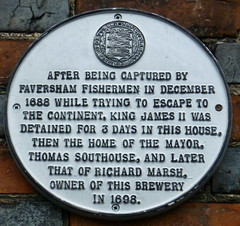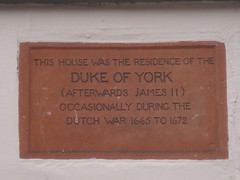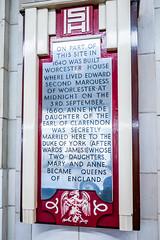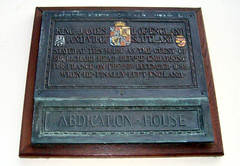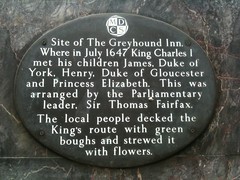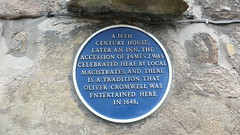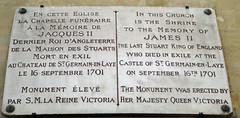King James II of England


King James II of England
(1633-1701)
King of Scots (1685-1688) and King of England (1685-1688)
Family tree
-
King Charles I of England (1600-1649) King of England
mother?
- King James II of England (1633-1701)
- Princess Henrietta of England (1644-1670) Princess of England
- King Charles II of England (1630-1685) King of England
- Sir Duke Henry Stuart KG (1640-1660) Duke of Gloucester
- Princess Elizabeth Stuart (1635-1650) Princess
- Princess Anne of England (1637-1640) Princess of England
- Mary , Princess Royal (1631-1660) Princess Royal
Commemorated on 9 plaques
Here lived Henry Hatch, merchant, adventurer and benefactor of the town. Died 1533. To this house was brought King James II when captured in attempting to leave the kingdom, December, 1688.
12 Market Place, Faversham, United Kingdom where they was brought
After being captured by Faversham fishermen in December 1688 while trying to escape to the continent, King James II was detained for 3 days in this house, then the home of the Mayor, Thomas Southouse, and later that of Richard Marsh, owner of this brewery in 1698.
Quay Lane, Faversham, United Kingdom where they was detained
This house was the residence of the Duke of York (afterwards James II) occasionally during the Dutch War 1665 to 1672
58 High Street, Southwold, United Kingdom where they lived
On part of this site in 1640 was built Worcester House where lived Edward second Marquess of Worcester. At midnight on the 3rd. September, 1660, Anne Hyde daughter of the Earl of Clarendon was secretly married here to the Duke of York (afterwards James II) whose two daughters, Mary and Anne, became Queens of England.
Savoy Court, London, United Kingdom where they was secretly married here to Anne Hyde (1659)
King James II of England and VII of Scotland stayed at this house as the guest of Sir Richard Head before embarking for France on the 25th December 1688 when he finally left England.
Abdication House, High St, Rochester, United Kingdom where they stayed
Site of The Greyhound Inn Where in July 1647 King Charles I met his children James, Duke of York, Henry, Duke of Gloucester and Princess Elizabeth. This was arranged by the Parliamentary leader, Sir Thomas Fairfax. The local people decked the King's route with green boughs and strewed it with flowers.
66 High Street, Maidenhead, Berkshire, SL6 1PY, Maidenhead, United Kingdom where they was
A 16th century house, later an inn, the accession of James 2 was celebrated here by local magistrates and there is a tradition that Oliver Cromwell was entertained here in 1648.
30 The Bank, Barnard Castle, United Kingdom where they is commemorated
En cette Eglise la Chapelle funéraire à la Mémoire de Jacques II, dernier Roi d'Angleterre de la Maison des Stuarts, mort en exil au Chateau de St. Germain-en-Laye le 16 septembre 1701. Monument élevé par S.M. la Reine Victoria. ---------- In this Church is the Shrine to the Memory of James II, the last Stuart King of England, who died in exile at the Castle of St. Germain-en-Laye on September 16th, 1701. The Monument was erected by Her Majesty Queen Victoria.
English translation: In this Church is the Shrine to the Memory of James II, the last Stuart King of England, who died in exile at the Castle of St. Germain-en-Laye on September 16th, 1701. The Monument was erected by Her Majesty Queen Victoria.
rue de la Paroisse, Saint-Germain-en-Laye, France where they was buried (1701)
Ci-gît le Roi Jacques VII d'Ecosse, II d'Angleterre, 1633 - 1701. Partenaire fidèle de la Vielle Alliance Franco-Ecossaise. ---------- Here lies King James VII of Scotland, II of England, 1633 - 1701. Loyal partner in the Franco Scottish Auld Alliance.
English translation: Here lies King James VII of Scotland, II of England, 1633 - 1701. Loyal partner in the Franco Scottish Auld Alliance.
Rue de la Paroisse, Saint-Germain-en-Laye, France where they was buried (1701)


